12: Movement
- Page ID
- 126926
\( \newcommand{\vecs}[1]{\overset { \scriptstyle \rightharpoonup} {\mathbf{#1}} } \)
\( \newcommand{\vecd}[1]{\overset{-\!-\!\rightharpoonup}{\vphantom{a}\smash {#1}}} \)
\( \newcommand{\dsum}{\displaystyle\sum\limits} \)
\( \newcommand{\dint}{\displaystyle\int\limits} \)
\( \newcommand{\dlim}{\displaystyle\lim\limits} \)
\( \newcommand{\id}{\mathrm{id}}\) \( \newcommand{\Span}{\mathrm{span}}\)
( \newcommand{\kernel}{\mathrm{null}\,}\) \( \newcommand{\range}{\mathrm{range}\,}\)
\( \newcommand{\RealPart}{\mathrm{Re}}\) \( \newcommand{\ImaginaryPart}{\mathrm{Im}}\)
\( \newcommand{\Argument}{\mathrm{Arg}}\) \( \newcommand{\norm}[1]{\| #1 \|}\)
\( \newcommand{\inner}[2]{\langle #1, #2 \rangle}\)
\( \newcommand{\Span}{\mathrm{span}}\)
\( \newcommand{\id}{\mathrm{id}}\)
\( \newcommand{\Span}{\mathrm{span}}\)
\( \newcommand{\kernel}{\mathrm{null}\,}\)
\( \newcommand{\range}{\mathrm{range}\,}\)
\( \newcommand{\RealPart}{\mathrm{Re}}\)
\( \newcommand{\ImaginaryPart}{\mathrm{Im}}\)
\( \newcommand{\Argument}{\mathrm{Arg}}\)
\( \newcommand{\norm}[1]{\| #1 \|}\)
\( \newcommand{\inner}[2]{\langle #1, #2 \rangle}\)
\( \newcommand{\Span}{\mathrm{span}}\) \( \newcommand{\AA}{\unicode[.8,0]{x212B}}\)
\( \newcommand{\vectorA}[1]{\vec{#1}} % arrow\)
\( \newcommand{\vectorAt}[1]{\vec{\text{#1}}} % arrow\)
\( \newcommand{\vectorB}[1]{\overset { \scriptstyle \rightharpoonup} {\mathbf{#1}} } \)
\( \newcommand{\vectorC}[1]{\textbf{#1}} \)
\( \newcommand{\vectorD}[1]{\overrightarrow{#1}} \)
\( \newcommand{\vectorDt}[1]{\overrightarrow{\text{#1}}} \)
\( \newcommand{\vectE}[1]{\overset{-\!-\!\rightharpoonup}{\vphantom{a}\smash{\mathbf {#1}}}} \)
\( \newcommand{\vecs}[1]{\overset { \scriptstyle \rightharpoonup} {\mathbf{#1}} } \)
\( \newcommand{\vecd}[1]{\overset{-\!-\!\rightharpoonup}{\vphantom{a}\smash {#1}}} \)
\(\newcommand{\avec}{\mathbf a}\) \(\newcommand{\bvec}{\mathbf b}\) \(\newcommand{\cvec}{\mathbf c}\) \(\newcommand{\dvec}{\mathbf d}\) \(\newcommand{\dtil}{\widetilde{\mathbf d}}\) \(\newcommand{\evec}{\mathbf e}\) \(\newcommand{\fvec}{\mathbf f}\) \(\newcommand{\nvec}{\mathbf n}\) \(\newcommand{\pvec}{\mathbf p}\) \(\newcommand{\qvec}{\mathbf q}\) \(\newcommand{\svec}{\mathbf s}\) \(\newcommand{\tvec}{\mathbf t}\) \(\newcommand{\uvec}{\mathbf u}\) \(\newcommand{\vvec}{\mathbf v}\) \(\newcommand{\wvec}{\mathbf w}\) \(\newcommand{\xvec}{\mathbf x}\) \(\newcommand{\yvec}{\mathbf y}\) \(\newcommand{\zvec}{\mathbf z}\) \(\newcommand{\rvec}{\mathbf r}\) \(\newcommand{\mvec}{\mathbf m}\) \(\newcommand{\zerovec}{\mathbf 0}\) \(\newcommand{\onevec}{\mathbf 1}\) \(\newcommand{\real}{\mathbb R}\) \(\newcommand{\twovec}[2]{\left[\begin{array}{r}#1 \\ #2 \end{array}\right]}\) \(\newcommand{\ctwovec}[2]{\left[\begin{array}{c}#1 \\ #2 \end{array}\right]}\) \(\newcommand{\threevec}[3]{\left[\begin{array}{r}#1 \\ #2 \\ #3 \end{array}\right]}\) \(\newcommand{\cthreevec}[3]{\left[\begin{array}{c}#1 \\ #2 \\ #3 \end{array}\right]}\) \(\newcommand{\fourvec}[4]{\left[\begin{array}{r}#1 \\ #2 \\ #3 \\ #4 \end{array}\right]}\) \(\newcommand{\cfourvec}[4]{\left[\begin{array}{c}#1 \\ #2 \\ #3 \\ #4 \end{array}\right]}\) \(\newcommand{\fivevec}[5]{\left[\begin{array}{r}#1 \\ #2 \\ #3 \\ #4 \\ #5 \\ \end{array}\right]}\) \(\newcommand{\cfivevec}[5]{\left[\begin{array}{c}#1 \\ #2 \\ #3 \\ #4 \\ #5 \\ \end{array}\right]}\) \(\newcommand{\mattwo}[4]{\left[\begin{array}{rr}#1 \amp #2 \\ #3 \amp #4 \\ \end{array}\right]}\) \(\newcommand{\laspan}[1]{\text{Span}\{#1\}}\) \(\newcommand{\bcal}{\cal B}\) \(\newcommand{\ccal}{\cal C}\) \(\newcommand{\scal}{\cal S}\) \(\newcommand{\wcal}{\cal W}\) \(\newcommand{\ecal}{\cal E}\) \(\newcommand{\coords}[2]{\left\{#1\right\}_{#2}}\) \(\newcommand{\gray}[1]{\color{gray}{#1}}\) \(\newcommand{\lgray}[1]{\color{lightgray}{#1}}\) \(\newcommand{\rank}{\operatorname{rank}}\) \(\newcommand{\row}{\text{Row}}\) \(\newcommand{\col}{\text{Col}}\) \(\renewcommand{\row}{\text{Row}}\) \(\newcommand{\nul}{\text{Nul}}\) \(\newcommand{\var}{\text{Var}}\) \(\newcommand{\corr}{\text{corr}}\) \(\newcommand{\len}[1]{\left|#1\right|}\) \(\newcommand{\bbar}{\overline{\bvec}}\) \(\newcommand{\bhat}{\widehat{\bvec}}\) \(\newcommand{\bperp}{\bvec^\perp}\) \(\newcommand{\xhat}{\widehat{\xvec}}\) \(\newcommand{\vhat}{\widehat{\vvec}}\) \(\newcommand{\uhat}{\widehat{\uvec}}\) \(\newcommand{\what}{\widehat{\wvec}}\) \(\newcommand{\Sighat}{\widehat{\Sigma}}\) \(\newcommand{\lt}{<}\) \(\newcommand{\gt}{>}\) \(\newcommand{\amp}{&}\) \(\definecolor{fillinmathshade}{gray}{0.9}\)Paints cannot physically move on our canvas, but artists can paint in a way that gives the illusion or suggestion of movement. This typically involves arranging shapes in a way that leads the viewer from one point to the next in the painting; or using certain techniques with the brush or palette knife to mimic movement.
Perhaps the best example of movement in art (or at least the most famous) is Vincent van Gogh's The Starry Night, featured as the cover image for this chapter, which takes your eyes on a rollercoaster around all the twists and swirls. A similar daytime painting by Van Gogh, seen below, also captures the feeling of movement.
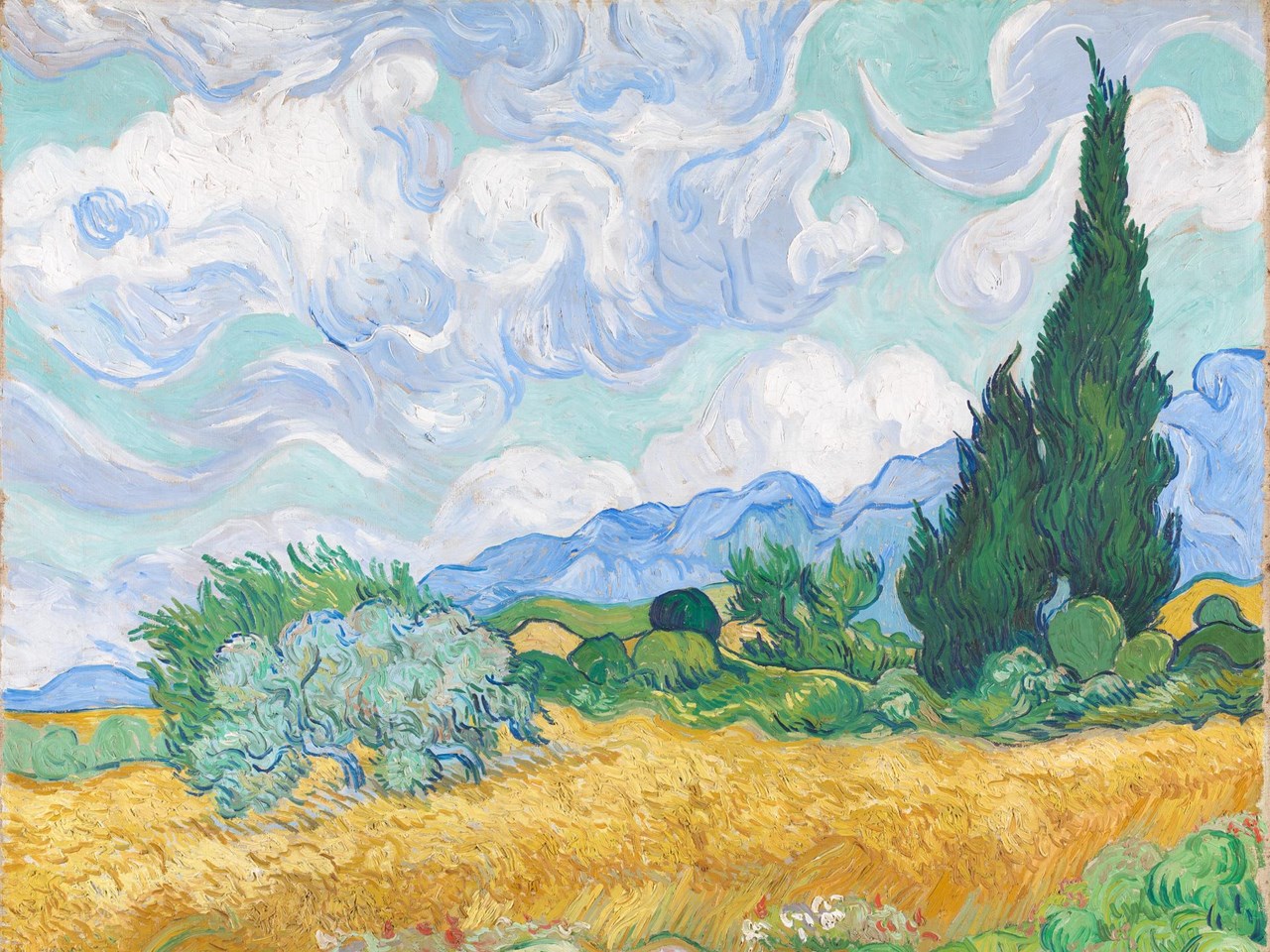
Movement… sounds exciting doesn’t it – like dancing. Dance itself, is an art form entirely based on movement. Visual art uses movement as well, but in a different way. In the painting below, by John Singer Sargent, we see the rhythm of the waves creating the illusion of movement.

Visual movement is the principle of art used to create the impression of action in a work of art. In the painting below, by George Bellows, we see violent movement in the ring as two boxers struggle during a bout. The action is made even more dramatic through the use of strong lighting on the subject (chiaroscuro).

Movement can apply to a single component in a composition, or to the whole composition at once. Visual movement is dependent on the other elements and principles of art. Rhythm, line, color, balance, and space are all examples of elements and principles of art that can play a major role in developing movement in a work of art.
Creating Movement with Rhythm
In the arts, rhythm is most closely associated with music and dance. Musical rhythm involves a beat that is repeated over time. Visual rhythm is created by repeating shapes (a pattern), lines, colors, or any other visual component.
Visual rhythm is everywhere. Rows of windows and columns add rhythm to architecture. Books on a shelf and tiled floors add rhythm to daily life. Each of these examples have something that is repeated. In the painting below, we see rhythm established by the lining up of similar forms and shapes representing cars, people, and buildings.
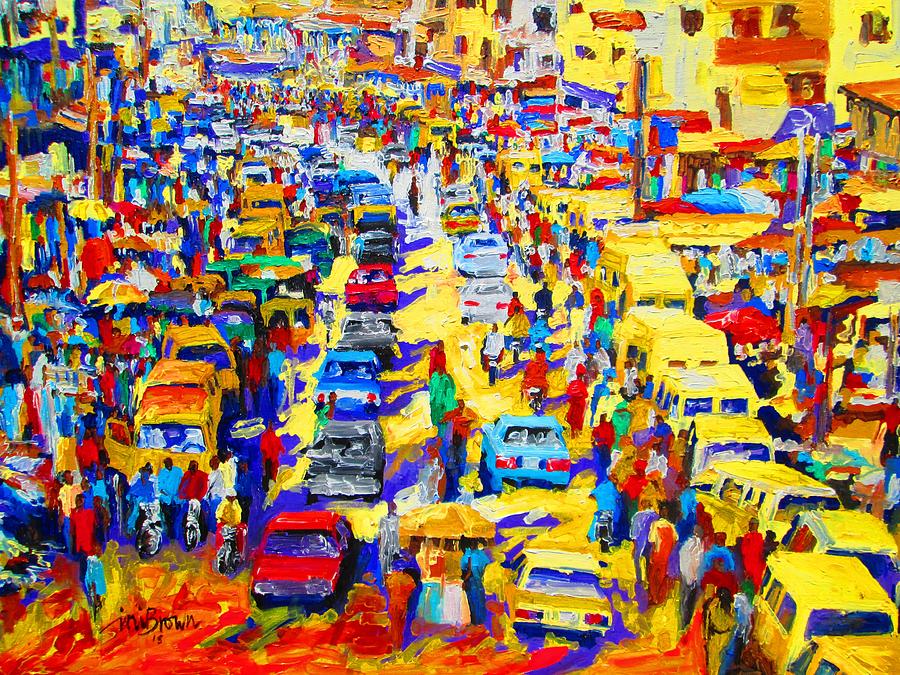
The repeating element is generally referred to as a motif. To create movement through rhythm, an artwork must have a motif. In the artwork below we see organic shapes repeated in a vertical orientation. Both have the suggestion of movement. The dancers suggest a vibrant dance through the bands of color representing the costumes and the movement of hands, arms and heads in dramatic fashion. The green organic plant-like forms suggest seaweed swaying in ocean swells or other natural forms.
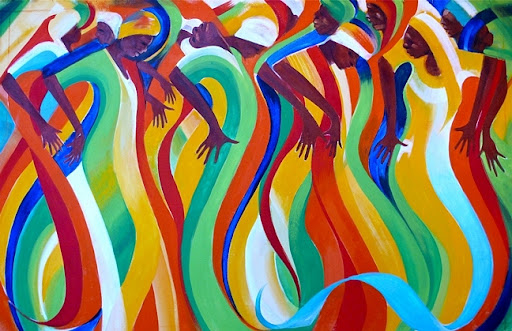
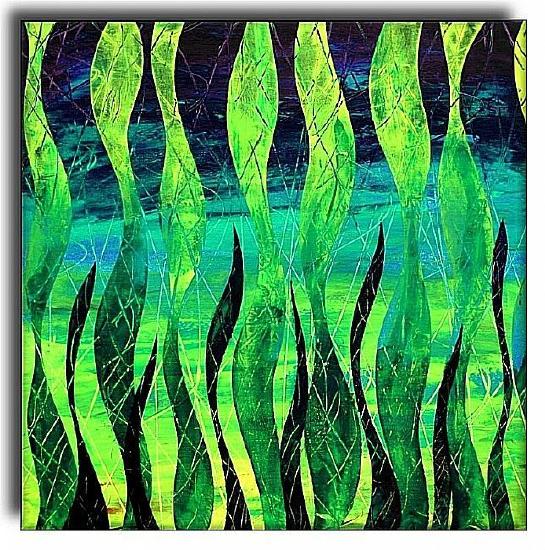
If a motif is variable in size and spacing, then the rhythm is said to be irregular. An irregular rhythm feels natural. Trees growing in a forest have an irregular rhythm. Each tree is unique. Some are thin and some are wide, but all are trees. The arrangement of wild flowers in a garden also create an aesthetically pleasing organic rhythm. The below painting beautifully captures that quality.
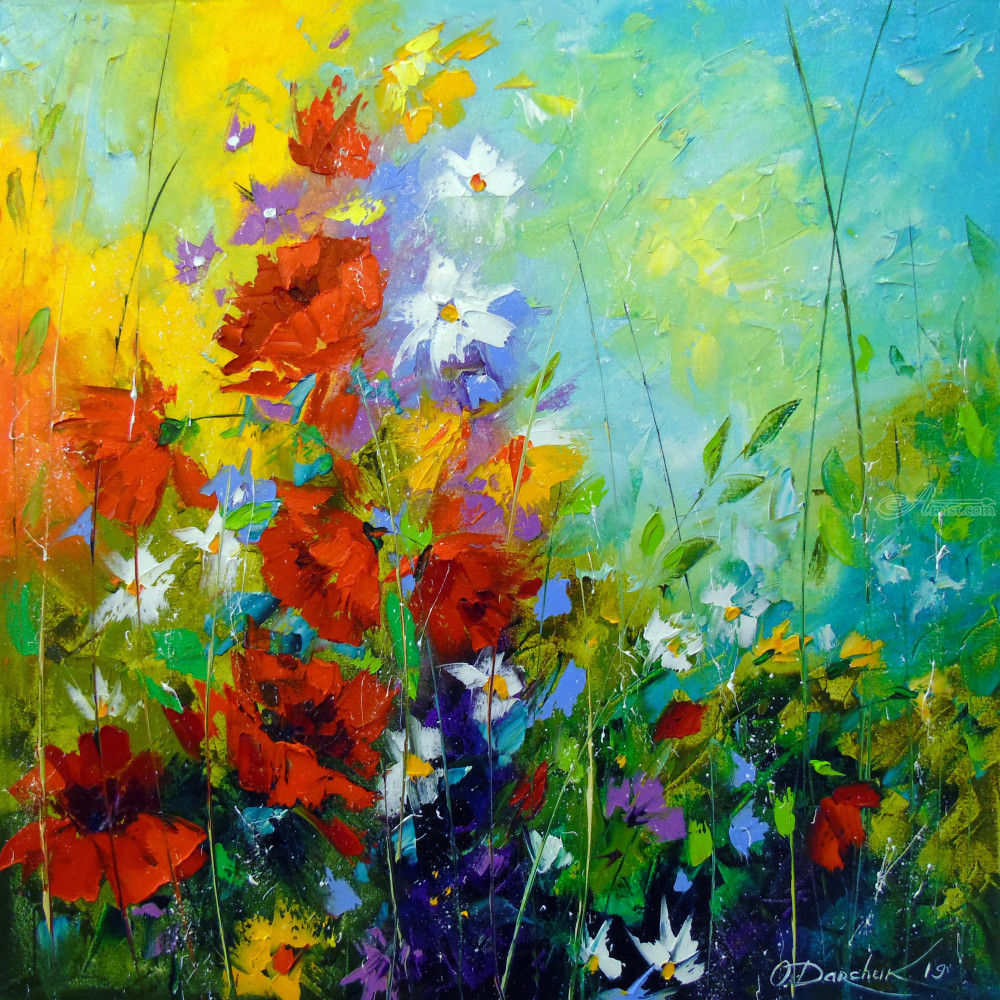
Assignment:
Part 1:
Use photography (your own), cut paper, ink drawing, color pencils and/or painting to create an abstract 2-D or representational composition showing movement.
This assignment is “wide open” to allow you to express yourself. Genre explored can be exaggerated forms creating movement and tension, cartoons, series of images showing the passage of time, images indicating natural growth or other images indicating movement. Use your imagination. Always remember that the DESIGN is still the most important consideration.
Take considerable time to closely examine design techniques learned from previous chapters and how you apply them in your composition. The placement of Line, Shape and Color should be an intellectual process that you can defend. Does the Visual Field have a vertical and horizontal grid? Are Line and Shape relating clearly to the Visual Field edge? Are you utilizing the available art tools such as squares, compass and French curves to assist you in the assembly and creation of the composition?
Artistic craftsmanship is becoming more and more critical as the semester continues. Again, are you making progress and improving in this critical area?
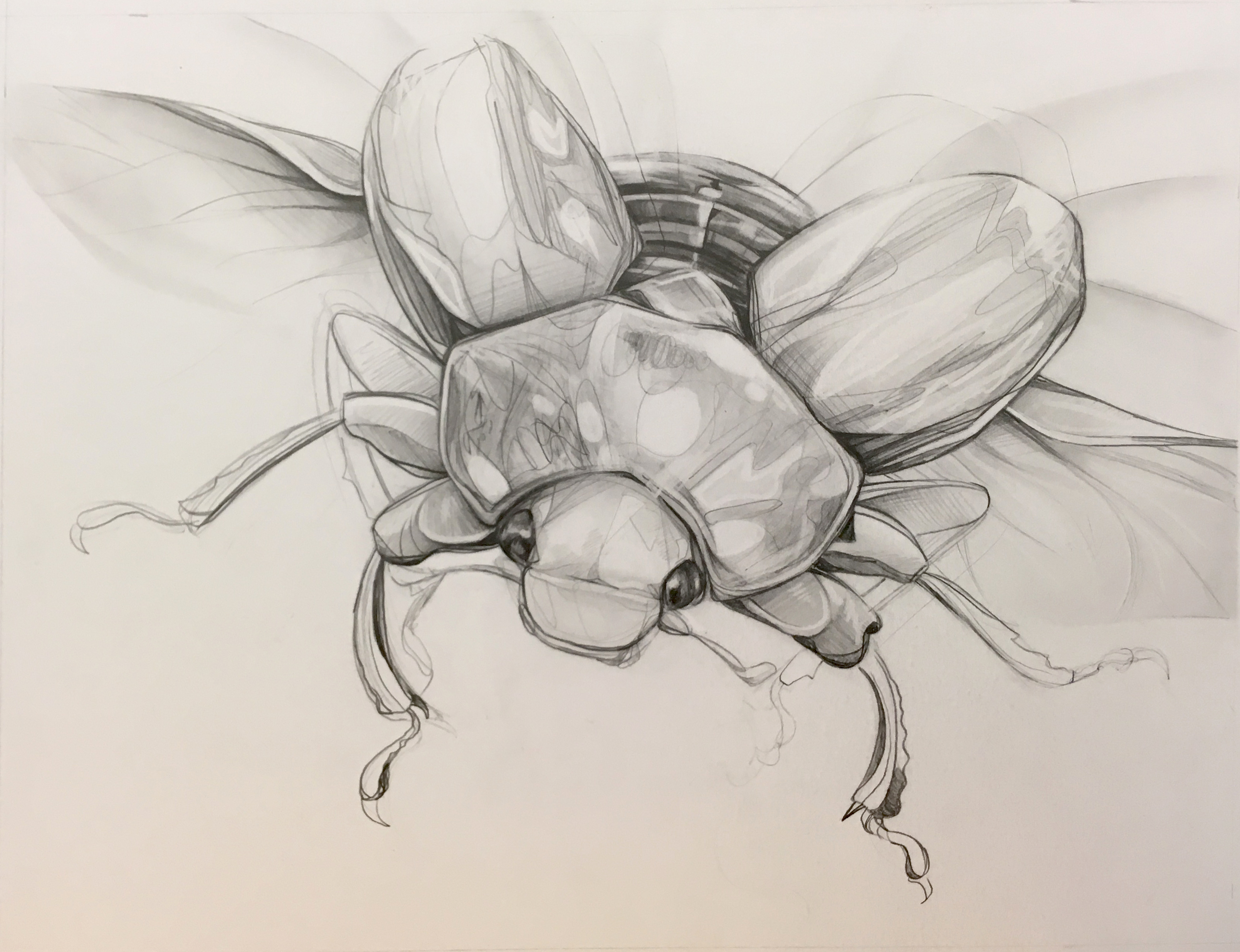
Student work by Mariana Nuñez
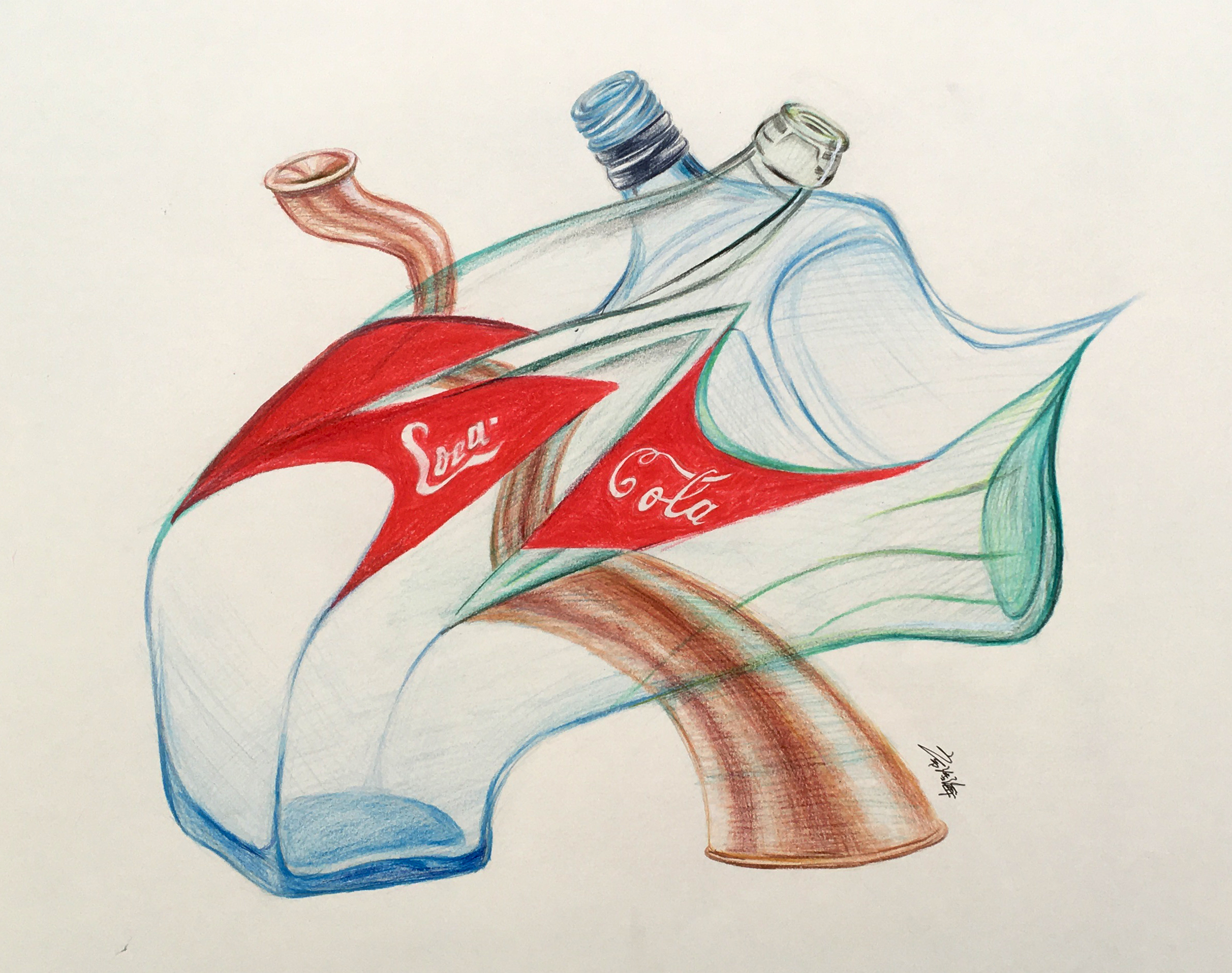
Student work
Part 2:
On a separate sheet of paper list the design considerations incorporated into Part 1. Be prepared to defend during critique your list relative to your design.


